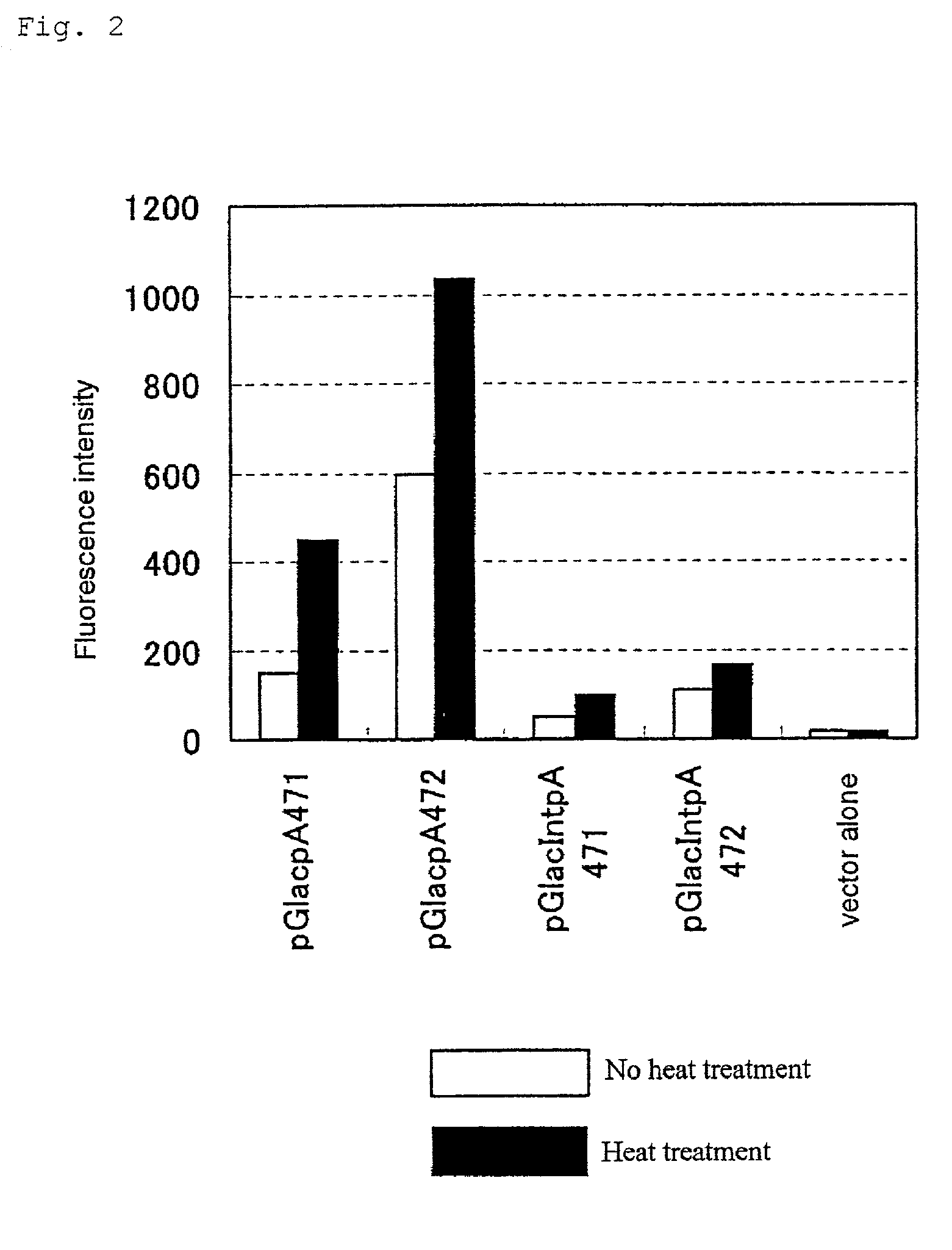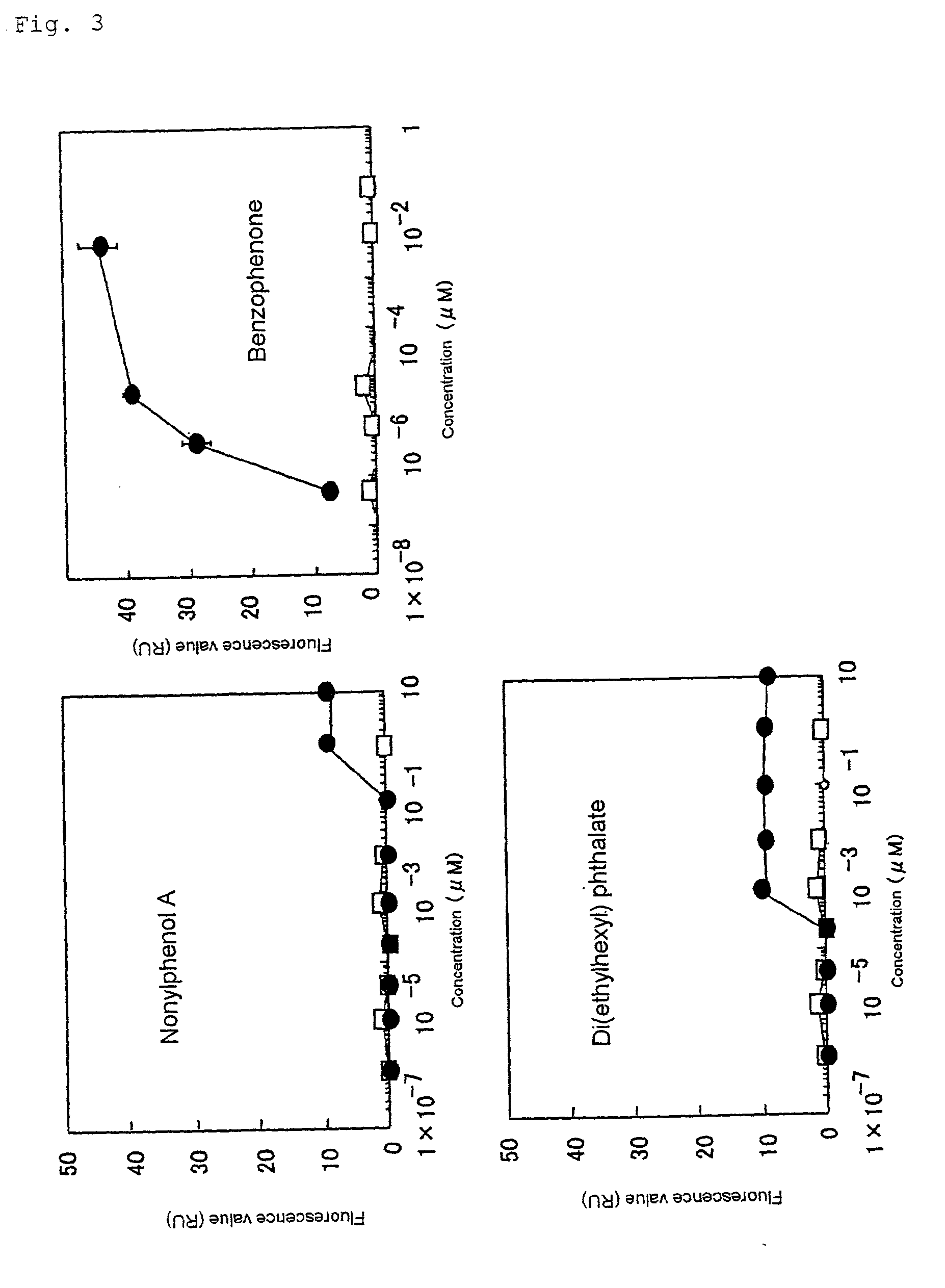High-sensitive detection of environmental pollutants
a technology of environmental pollutants and high-sensitivity detection, which is applied in the field of high-sensitivity detection of environmental pollutants, can solve the problems of inability to test enormous chemicals and their synergistic effects, the death of domestic and wild animals as well as human illness, and the death of dialysis patients in brazil of acute hepatic failur
- Summary
- Abstract
- Description
- Claims
- Application Information
AI Technical Summary
Problems solved by technology
Method used
Image
Examples
example 1
[0065] (Construction of Vectors Capable of Inducing Expression of .beta.-galactosidase in a Stress-Specific Manner)
[0066] The vectors shown in FIG. 1 were constructed. Thus, an expression plasmid named pGlacpA472 (6.5 kbp) was constructed by connecting the restriction enzyme AvaII (-197 to +38) fragment (cf. GENE, (126), 187, 1993) containing the heat shock factor binding DNA sequence (HSE) of the mouse HSP47 promoter to a 3.1-kb HindIII fragment containing the structural gene for .beta.-galactosidase on the upstream side of the HindIII fragment in the direction enabling mRNA transcription, joining, immediately behind the same, about 220 bp from the restriction enzyme FbaI (nucleotide No. 2770 of SV40) site to the BamHI (nucleotide No. 2553) site of SV40 containing the SV40 late pA signal sequence, and connecting the resulting fragment to the BamHI-SacI fragment (about 3.2 kbp) containing the ampicillin resistance gene, of the pGL2control vector (Promega) as the basic skeleton. pGla...
example 2
Preparation of CHO Cells for Detecting Environmental Contaminant Substances
[0071] Chinese hamster ovary (CHO) cells were transformed simultaneously with the plasmid pGlacpA472 having the .beta.-galactosidase gene connected to the HSP47 promoter on the downstream side thereof and the neomycin resistance gene expression vector pSV2neo and, then, stable transformants were selected using the antibiotic G418. The stable transformants obtained were exposed to heat as a typical example of stress stimulation. The strain found to be most highly capable of inducing .beta.-galactosidase activity expression was named 2F1813 (this was deposited on Aug. 17, 2001 at National Institute of Advanced Industrial Science and Technology International Patent Organism Depositary and given a domestic deposition number, FERM P-18473. It was transferred to the international deposition phase based on the Budapest Treaty and on Feb. 7, 2002, given an international deposition number, FERM BP-7876) and used in th...
example 3
Reporter Protein Activity Characteristics in Response to Environmental Pollution
[0074] Culture of cells 2F1813 cells was used. The medium used was MD medium (MCDB 302: 5.5 g / liter, D-MEM: 4.75 g / liter, L-glutamine: 0.3 g / liter, NaHCO.sub.3: 1.27 g / liter, kanamycin: 0.1 g / liter, pH 7.1) supplemented with a final concentration of 5% of FBS (fetal bovine serum) and 200 .mu.g / ml of G418, and culture was carried out at 37.degree. C. in 5% CO.sub.2. Two days before the test, the wells of a 96-well plate were seeded with 1.times.10.sup.4 cells / 100 .mu.l / well. The chemical substances submitted to the test were, di(ethylhexyl) phthalate (DEHP), benzophenone, nonylphenol A, o-dichlorobenzene tetrachloroethylene, 1,1,2-trichloroethane, 1,4-dioxane, trichloroethylene, 1,2-dichloroethane, fluorene and phenanthrene. These compounds were dissolved in methanol and then diluted at least 1,000-fold with MD medium after which they were used to treat the cells. Standard solutions (1,000 mg / l) of cadmiu...
PUM
| Property | Measurement | Unit |
|---|---|---|
| Mass | aaaaa | aaaaa |
| Mass | aaaaa | aaaaa |
| Mass | aaaaa | aaaaa |
Abstract
Description
Claims
Application Information
 Login to View More
Login to View More - R&D
- Intellectual Property
- Life Sciences
- Materials
- Tech Scout
- Unparalleled Data Quality
- Higher Quality Content
- 60% Fewer Hallucinations
Browse by: Latest US Patents, China's latest patents, Technical Efficacy Thesaurus, Application Domain, Technology Topic, Popular Technical Reports.
© 2025 PatSnap. All rights reserved.Legal|Privacy policy|Modern Slavery Act Transparency Statement|Sitemap|About US| Contact US: help@patsnap.com



